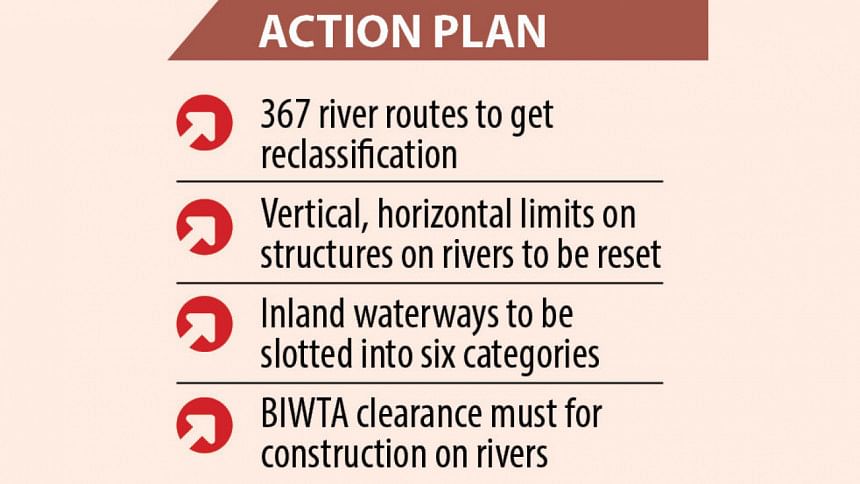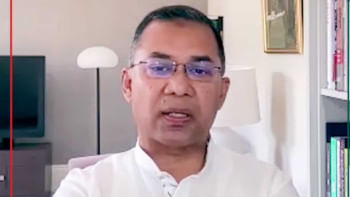New classification of rivers on way

The Bangladesh Inland Water Transport Authority (BIWTA) is set to classify 10,187km of non-classified river aiming to protect them from unplanned structures, including bridges and culverts.
It is also reviewing the vertical and horizontal limits already set for building bridges or other structures in or over the classified waterways.
The BIWTA has prepared a list of 367 river routes to be brought under classification afresh or to be reclassified and determined their standard high-water level (SHWL) and standard low-water level (SLWL) under a study project.
At present, only 5,968km of river on 95 routes are classified, meaning a total of 16,155km of river will be classified or reclassified once the draft rules incorporating the routes get approval.
The BIWTA, with assistance from the Institute of Water Modelling (IWM), is implementing the Tk 18.3 crore project titled "determination of SHWL, SHWL and re-classification of inland waterways in Bangladesh" from October 2021 to March 2024, said Project Director Rakibullah.
The development comes at a time when at least 308 rivers in Bangladesh have lost their navigability mainly due to unplanned structures in and over the water bodies.
The last time the river routes were classified was back in 1989. The river routes were classified into four classes based on the loaded draft of the mechanised cargo vessels and the least available depth requirement.
But numerous bridges and other structures have been constructed over the waterways obstructing navigation of bigger vessels later on, according to BIWTA officials.
Subsequently in 2010, the government published rules for control of construction of installations along the bank and foreshore of inland waterways.
The government made the BIWTA clearance mandatory before construction of installations over rivers, they said.
As per the 2010 rules, vertical and horizontal limits for class-I rivers would be 18.3 metres and 76.22 metres respectively.
For class II, the limits would be 12.2m and 76.22m; for class III, the vertical and horizontal limits are 7.62m and 30.48m respectively; and for class IV, the limits would be 5m and 20m, shows document.
And yet, agencies, especially while building small bridges, did not take the BIWTA's clearance, further obstructing the river navigability, they added.
Then in 2019, the BIWTA revised the rules incorporating 5,968km river under 95 routes.
Besides, the planning commission made BIWTA's clearance mandatory for getting approval for projects for building bridges and such structures, they said.
Still, low-height bridges were being constructed over the river routes that had not been classified and the BIWTA took up this project to bring more rivers under classification, they added.
The findings of the study were shared by officials of the BIWTA and the IWM yesterday at a workshop at the capital's Institution of Engineers, Bangladesh.
Data from the last 25 years of 442 water-level stations from four different organisations including BIWTA and Bangladesh Water Development Board were considered to determine the SHWL and the SLWL.
As per the study, the SHWL is the water level that is exceeded 2 percent of the time and the SLWL is the water level that is exceeded 95 percent of the time over a considerable period.
The inland waterways would be classified into six classes instead of the existing four classes considering the least available depth, the importance of the waterway, the traffic intensity and the level of dependency on the route.
The six categories would be Class-S (specialised), class-I, II, III, IV and V.
The vertical and horizontal limits for class-S river would be 20m and 100m respectively; while 18.5m and 100m for class I; 12.5m and 75m for class II and 8m and 35m for class III, 5m and 25m for class IV and 3.5m and 20m for class V, shows document.
Only three routes will fall under class S, while 41 will be under class I, 46 under class II, 112 under class III, 109 under class IV and 56 under class V, it shows.
In their recommendations, the officials said rules to control the construction of installations in or over the waterways shall be implemented strictly; routes, SHWL and SLWL should be reviewed and updated regularly.
Officials of the Roads and Highways Department, the Bangladesh Railway and the Local Government Engineering Department (LGED), however, criticised some observations and opinions mentioned in the study.
They said the classification of some of the rivers should be changed, for say, both Jamuna and Turag. They have very contrasting scenarios and yet remain enlisted in the same class-II category.
They said vertical clearance for four category rivers has been increased and it would have a serious cost impact on government bridge projects.
They also recommend that the authority first fix what types of vessels would be allowed in which routes and classify the rivers considering those vessels.
Many bridges have to be demolished if the new classification is applied, said an LGED engineer.
BIWTA Chairman Arif Ahmed Mustafa, however, said they were not asking them to demolish bridges but keep the classifications in mind for future projects.
"It is the duty of all and not only the shipping or water resources ministries to save the rivers," said Khalid Mahmud Chowdhury, the state minister for shipping.
So, there should be coordination here, he said, while urging the authorities concerned to give priority to rivers and project costs.

 For all latest news, follow The Daily Star's Google News channel.
For all latest news, follow The Daily Star's Google News channel. 



Comments